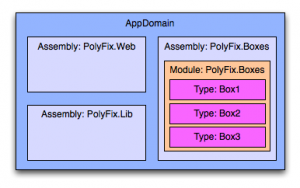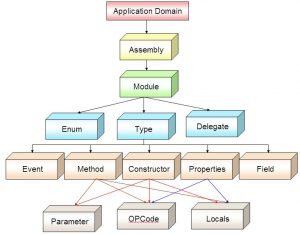前言
本文主要给大家介绍了关于C#基础之Attribute和反射的相关内容,分享出来供大家参考学习,下面话不多说了,来一起看看详细的介绍吧。
Attribute(特性)
Attribute是C#的一种语言特性,用于为各种实体(class,field,property)附加一些说明性信息, 并且可以在运行时环境中检索这些信息(通过反射)。
所有的Attribute必须继承自Attribute类,按照约定,特性类的名称带有 Attribute 后缀。使用特性时可以包含或省略此后缀。
AttributeUsage
AttributeUsage是Attribute的Attribute,用于给自定义的Attribute加一些限定。
AttributeTargets
AllowMultiple
Inherited
AttributeTargets指定你这个attribute限制用于哪类实体上,在这里,实体是指: class、method、constructor、field、property、GenericParameter或者用All,表明可用于所有实体。每个target标记可以用|链接,如AttributeTargets.Class|AttributeTargets.Method表示这个attribute可用于class或者method。
下面例子表明了每种target的用法:
using System;
namespace AttTargsCS {
// This attribute is only valid on a class.
[AttributeUsage(AttributeTargets.Class)]
public class ClassTargetAttribute : Attribute {
}
// This attribute is only valid on a method.
[AttributeUsage(AttributeTargets.Method)]
public class MethodTargetAttribute : Attribute {
}
// This attribute is only valid on a constructor.
[AttributeUsage(AttributeTargets.Constructor)]
public class ConstructorTargetAttribute : Attribute {
}
// This attribute is only valid on a field.
[AttributeUsage(AttributeTargets.Field)]
public class FieldTargetAttribute : Attribute {
}
// This attribute is valid on a class or a method.
[AttributeUsage(AttributeTargets.Class|AttributeTargets.Method)]
public class ClassMethodTargetAttribute : Attribute {
}
// This attribute is valid on a generic type parameter.
[AttributeUsage(AttributeTargets.GenericParameter)]
public class GenericParameterTargetAttribute : Attribute {
}
// This attribute is valid on any target.
[AttributeUsage(AttributeTargets.All)]
public class AllTargetsAttribute : Attribute {
}
[ClassTarget]
[ClassMethodTarget]
[AllTargets]
public class TestClassAttribute {
[ConstructorTarget]
[AllTargets]
TestClassAttribute() {
}
[MethodTarget]
[ClassMethodTarget]
[AllTargets]
public void Method1() {
}
[FieldTarget]
[AllTargets]
public int myInt;
public void GenericMethod<
[GenericParameterTarget, AllTargets] T>(T x) {
}
static void Main(string[] args) {
}
}
}
AllowMultiple
AllowMultiple表明了这个attribute可否多次应用于同一个实体,默认为false
[AttributeUsage(AttributeTargets.Class, AllowMultiple = true)]
class MultiUseAttr : Attribute { }
[MultiUseAttr, MultiUseAttr]
class Class2 { }
Inherited
Inherited表明这个attribute是否可以被继承传递,即子类或子类从父类继承的成员是否带这个attribute,默认为true
[AttributeUsage(AttributeTargets.Class | AttributeTargets.Method |
AttributeTargets.Property | AttributeTargets.Field,
Inherited = true)]
public class InheritedAttribute : Attribute
{}
[AttributeUsage(AttributeTargets.Class | AttributeTargets.Method |
AttributeTargets.Property | AttributeTargets.Field,
Inherited = false)]
public class NotInheritedAttribute : Attribute
{}
using System;
using System.Reflection;
[InheritedAttribute]
public class BaseA
{
[InheritedAttribute]
public virtual void MethodA()
{}
}
public class DerivedA : BaseA
{
public override void MethodA()
{}
}
[NotInheritedAttribute]
public class BaseB
{
[NotInheritedAttribute]
public virtual void MethodB()
{}
}
public class DerivedB : BaseB
{
public override void MethodB()
{}
}
public class Example
{
public static void Main()
{
Type typeA = typeof(DerivedA);
Console.WriteLine("DerivedA has Inherited attribute: {0}",
typeA.GetCustomAttributes(typeof(InheritedAttribute), true).Length > 0);
MethodInfo memberA = typeA.GetMethod("MethodA");
Console.WriteLine("DerivedA.MemberA has Inherited attribute: {0}\n",
memberA.GetCustomAttributes(typeof(InheritedAttribute), true).Length > 0);
Type typeB = typeof(DerivedB);
Console.WriteLine("DerivedB has Inherited attribute: {0}",
typeB.GetCustomAttributes(typeof(InheritedAttribute), true).Length > 0);
MethodInfo memberB = typeB.GetMethod("MethodB");
Console.WriteLine("DerivedB.MemberB has Inherited attribute: {0}",
memberB.GetCustomAttributes(typeof(InheritedAttribute), true).Length > 0);
}
}
// The example displays the following output:
// DerivedA has Inherited attribute: True
// DerivedA.MemberA has Inherited attribute: True
//
// DerivedB has Inherited attribute: False
// DerivedB.MemberB has Inherited attribute: False
反射
Reflection,中文翻译为反射,是审查元数据并收集关于它的类型信息的能力。元数据(编译以后的最基本数据单元)就是一大堆的表,当编译程序集或者模块时,编译器会创建一个类定义表,一个字段定义表,和一个方法定义表等。
反射是.Net中获取运行时类型信息的方式,.Net的应用程序由几个部分:‘程序集(Assembly)'、‘模块(Module)'、‘类型(class)'组成,而反射提供一种编程的方式,让程序员可以在程序运行期获得这几个组成部分的相关信息, Assemblies contain modules. Modules contain classes. Classes contain functions.

System.reflection命名空间包含的几个类,允许你反射(解析)这些元数据表的代码
System.Reflection.Assembly
System.Reflection.MemberInfo
System.Reflection.EventInfo
System.Reflection.FieldInfo
System.Reflection.MethodBase
System.Reflection.ConstructorInfo
System.Reflection.MethodInfo
System.Reflection.PropertyInfo
System.Type

以下是上面几个类的使用方法:
使用Assembly定义和加载程序集,加载在程序集清单中列出模块,以及从此程序集中查找类型并创建该类型的实例。
使用Module了解包含模块的程序集以及模块中的类等,还可以获取在模块上定义的所有全局方法或其他特定的非全局方法。
使用ConstructorInfo了解构造函数的名称、参数、访问修饰符(如pulic 或private)和实现详细信息(如abstract或virtual)等。
使用Type的GetConstructors或 GetConstructor方法来调用特定的构造函数。
使用MethodInfo了解方法的名称、返回类型、参数、访问修饰符(如pulic 或private)和实现详细信息(如abstract或virtual)等。
使用Type的GetMethods或GetMethod方法来调用特定的方法。
使用FiedInfo了解字段的名称、访问修饰符(如public或private)和实现详细信息(如static)等,并获取或设置字段值。
使用EventInfo了解事件的名称、事件处理程序数据类型、自定义属性、声明类型和反射类型等,添加或移除事件处理程序。
使用PropertyInfo了解属性的名称、数据类型、声明类型、反射类型和只读或可写状态等,获取或设置属性值。
使用ParameterInfo了解参数的名称、数据类型、是输入参数还是输出参数,以及参数在方法签名中的位置等。
反射的作用:
可以使用反射动态地创建类型的实例,将类型绑定到现有对象,或从现有对象中获取类型
应用程序需要在运行时从某个特定的程序集中载入一个特定的类型,以便实现某个任务时可以用到反射。
使用反射获取类型
public void Process(object processObj)
{
Type t = processsObj.GetType();
if(t.GetInterface(“ITest”) !=null)
…
}
创建一个对象
public class TestClass {
private string _value;
public TestClass() {
}
public TestClass(string value) {
_value = value;
}
public string GetValue( string prefix ) {
if( _value==null )
return "NULL";
else
return prefix+" : "+_value;
}
//获取类型信息
Type t = Type.GetType("TestSpace.TestClass");
//构造器的参数
object[] constuctParms = new object[]{"timmy"};
//根据类型创建对象
object dObj = Activator.CreateInstance(t,constuctParms);
//获取方法的信息
MethodInfo method = t.GetMethod("GetValue");
//调用方法的一些标志位,这里的含义是Public并且是实例方法,这也是默认的值
BindingFlags flag = BindingFlags.Public | BindingFlags.Instance;
//GetValue方法的参数
object[] parameters = new object[]{"Hello"};
//调用方法,用一个object接收返回值
object returnValue = method.Invoke(dObj,flag,Type.DefaultBinder,parameters,null);
总结
以上就是这篇文章的全部内容了,希望本文的内容对大家的学习或者工作具有一定的参考学习价值,如果有疑问大家可以留言交流,谢谢大家对脚本之家的支持。





















 816
816











 被折叠的 条评论
为什么被折叠?
被折叠的 条评论
为什么被折叠?








